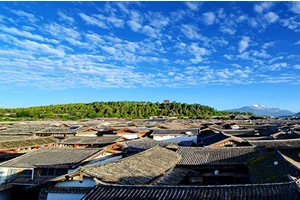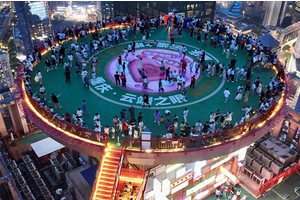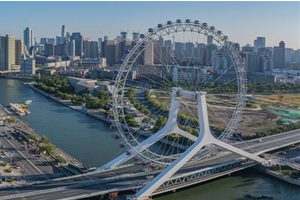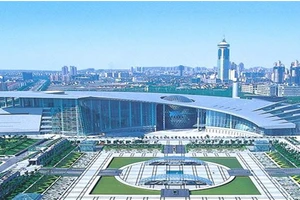Xinzhou tourist road
Xinzhou was called Xiurong in ancient times, also called Xin for short. Known as the "northern Shaanxi lock key", it is a city under the jurisdiction of Shanxi Province. Below, I have compiled a complete list of scenic spots that Xinzhou tourism has to go to, hoping to add icing on the cake to everyone's Xinzhou tourism.
A must-see spot for a one-day tour in Xinzhou
Fushanyuan
Fushan Garden is located on the west slope of Dengcun, adjacent to Dengcun Cultural Square in the north, covering an area of about 40 mu.
Fushanyuan was established in April 2007. Land provided by Duncun Hot Spring Tourism Development Co., Ltd. and invested by Duncun Hot Spring Resort Management Office are cultural tourist attractions jointly developed.
The Fushan Garden facing south is divided into two courtyards. The north courtyard that enters the gate is relatively large, and the east courtyard is a celebrity painting and calligraphy museum, where an exhibition of paintings by Mr. Lv Feng, a painter from Xinzhou City, was held. On the west side of the courtyard is Fu Shan Painting and Calligraphy Institute, which often holds painting and calligraphy activities, and is hung with paintings and calligraphy of relevant leaders and calligraphers. There are artificial lakes, rockeries and waterfalls in the courtyard. To the east of the artificial lake is the Fu Shan Monument Gallery, which contains 45 Fu Shan poems written by famous contemporary artists. Huxi is a cave with the characteristics of northern Shaanxi, which was built according to local conditions. Upstairs is the location of Fushan Culture Research Association, and downstairs is the Fukuyama farming culture memory exhibition hall.
The South Courtyard is an imitation of the Ming Dynasty residential courtyard, which is the newly-built former residence of Fu Shan. The courtyard is located in the west and east, and there are three west halls in the west. There is a 2.6-meter-high sandstone statue of Fu Shan in the hall, with wings on both sides, namely the study and pharmacy. The main room is Fu Shan's living room. An antique wooden partition divides the room into an inner room and an outer room. The inner room is a traditional kang and cooker, and the outer room is a living room. Nanfang is a big landscape of Xinzhou ancient rhyme folk custom. There are small clay sculptures of various folk activities in Ming and Qing Dynasties in Chen's Nanfang, which are vivid and lifelike. The East Room is the room where celebrities talk about Fu Shan. Fu Shan's works and the appreciation of celebrities in past dynasties are hung on the wall.
Fushan Garden is the spreading base of Fushan culture in Xinzhou at present, and it is also a major tourist attraction of Duncun Hot Spring Resort. Fu Shan Cultural Research Association holds theme activities here every year, and Fu Shan Painting and Calligraphy Institute holds paintings and exhibitions from time to time. Fushan Garden is a resort for people to travel, relax and spend their holidays.
The development of hot spring resort makes Duncun a star on the Universiade Expressway, and the government also takes Duncun as a window for external development in due course. I believe that with the joint efforts of all walks of life, the future of Duncun will be even better.
Dengcun International Ski Resort
Dengcun International Ski Resort is located in Dengcun, Xinzhou, a famous hot spring town in China. It is 1.5km away from the exit of Dengcun of Dayun Expressway, close to Dunqi Highway, 4km away from Xinzhou City and 60km away from Taiyuan, the provincial capital.
Adjacent to China are more than 20 tourist attractions such as Wutai Mountain, Wangyudong and Luya Mountain. Self-driving tourists only need half an hour's drive from Taiyuan to Xueyuan.
xingguo temple
Address: Xingsi Street, Xinfu District, Xinzhou City
Xingguo temple is located in Xingsi Street, Xinzhou City. According to the inscription, xingguo temple was founded in the sixth year of Wude, Tang Gaozu (623), formerly known as Guo Sheng Temple. In the first year of the Tang Dynasty (698), it was renamed Taiping xingguo temple, and in the Changxing period of the later Tang Dynasty (930-933), it was renamed xingguo temple. This temple used to be very large. Recently, when Tianwang Temple was renovated, it was found that there was a plank on the beam with the title: "The Tang Dynasty gave xingguo temple, Xinzhou City, peace, and there were twelve courtyards around it. Daming was rebuilt in Hongwu, Chenghua, Hongye and Jiajing in August. Today, in April of the eleventh year of Tongzhi in Qing Dynasty, the reconstruction of Buddhist temples, corridors and walls began. Zhou He rebuilt the gate of Wanshou Palace. If a large royal palace has never been maintained after the Qing Dynasty, coupled with man-made destruction, especially the demolition of the palace during the Guangxu period, it has almost become a ruin, leaving only one building. Master Jichang, president of the Buddhist Association of Xinfu District, saw this dilapidated situation and was determined to repair this ancient temple. The mage raised money everywhere to build a statue of a temple. Now the Hall of Great Heroes has been built, with two halls, the East Hall and the West Hall.
Opposite the Ursa Major Hall is the Heavenly King Hall, with 3 rooms wide and 3 rooms deep, resting on the top of the mountain, single eaves, lotus-shaped bucket arches and yellow glazed tiles. There are two pillars supporting the beams in the temple. This kind of structure is the "falling column method", which is a legacy of the Tang Dynasty. Xiangyang site
Address: 500 meters east of Xiangyang Village, Douluo Town, Xinfu District
The site is 800 meters long from east to west and 600 meters wide from north to south. It was discovered in 1957 and has not been excavated so far. The cultural layer is 0.5-2.5 meters thick, including Yangshao culture and Longshan culture, with Longshan culture as the main culture. The site has a semi-cave and a white ground. Unearthed cultural relics include pots and jars, and pottery includes red pottery, gray pottery and mixed sand pottery. Now part of it has been washed away by the Muma River, and the rest is intact.
The story of diusim cemetery
The story of Diusim, one of the four beauties in ancient China, was born in Muer Village, Jiuyuan County, Hezhou City. At the age of 15, he was elected to the palace, in charge of the Diusim story crown worn by courtiers (the hat of Han Dynasty attendants) and renamed Diusim story. Diusim's hometown is Mu Zhi Village, three kilometers southeast of Xinzhou City, on the way from Taiyuan or Xinzhou to Wang Yudong. Mu Zhi Village was originally rich in fungi, so it was named Mu Zhi Village. Later, because a thousand-year-old Ganoderma lucidum was found under the locust tree in the village, it was renamed Mu Zhi Village. It is widely rumored in the village that peaches and apricots in the village had stopped flowering three years before the birth of the story of Diusim, and it is still difficult for peach trees and apricot trees to survive, which means that the story of Diusim is ashamed of flowers. There used to be a street-crossing archway, a front hall, a back hall, Wang Yun Street, a Dixin stage and a Diaochan tomb in the village. The current tourist attraction is called the story of Diesim Cemetery, which was restored and built by villagers on the original site of the cemetery in recent years. On the eaves of the door, there is a horizontal plaque of "The Story of Diesim Cemetery", and on both sides, there are "It is the pride of China people to be ashamed of closing flowers on the moon"; Humiliation and danger really stopped the man. "According to villagers' legend, after the three brothers in Taoyuan gained power, they sent the story of Diusim back to their hometown and buried him here when he was old. He also told the story of Diusim throwing himself at the sword, and Guan Yu escorted the body back to his hometown for burial. Therefore, there is a statue of Guan Yu in the back hall, and there is a stage in front of the hall to show the story of Diusim's acting, which is a reward for Guan Yu's refusal to kill and escort. In addition, Zhonghuao Village in the southeast of Dingxiang County is the hometown of Lu Bu, and there are legends such as "Huo Qingquan", "Catch Red Rabbit" and "Twisted Neck Tree" among the people, all of which are related to Lu Bu.
Gongsun Chujiu Tomb
Gongsun Chujiu's Tomb is located one kilometer east of Xinzhou. Gongsun Chujiu was a native of Jin in the Spring and Autumn Period. In the third year of Jin Dynasty (597 BC), he conspired to hide Zhao's orphans and gave his life.
The existing ancestral halls and tombs in the tomb area are rectangular courtyards, covering an area of about 7 mu. There are more than 20 existing temples and 5 main halls, including Gongsun Chujiu Ancestral Hall, and there are statues of Gongsun Chujiu and his wife in the wooden pavilion of Shentai.
The tomb area is 200 meters south of the ancestral hall, and the tomb mound is 2.3 meters high. In front of the tomb, there is a monument to the tomb of Jin Gongsun in the eleventh year of Ming and Qing Dynasties.
Xian ren dong Jin' an temple
Eight rooms of Jin 'an Temple in Xianren Cave are 14.87 meters wide and two rooms are 5.45 meters deep. There is a black hole on the right wall, about 1 meter high, leading to another small temple in the east of the temple. Now, the small temple has been destroyed, leaving only a hanging post to support the temple, which swings from side to side when the wind blows slightly. Locals call it "Balazhu". It is said that this cave is 21 kilometers long and leads to the "Chaoyang Cave" of another mountain peak. Explorers used to enter Chaoyang Cave and walk for several kilometers. Because the cave is eerie and snakes often appear, I have to regret it.
Jin Dong Temple
Jin Dong Temple is located on the hillside 1.5 kilometers west of Xihu Rock Village, Hesuo Township, Xinfu District, Xinzhou City, Shanxi Province. Jin Dong Temple is located at the foot of Longmen Mountain, 20 kilometers west of Xinzhou City, also known as "Longmen Temple", covering an area of about 10 mu. It was originally composed of three monasteries, namely, upper, middle and lower monasteries. Guangjin Temple in the upper house is on the mountainside of Longmen, and Tietou Temple in the middle court is in the ravine of Longmen. The upper house and the Intermediate People's Court have been destroyed, and now only Jin Dong Temple is well preserved.
The main hall of Jin Dong Temple is Manjusri Hall, which is located on the 2-meter-high steps and is a ceiling building with a width of 10.5 meters and a depth of 11.7 meters. There is a Bodhisattva King Kong in the hall. The whole hall is magnificent, completely retaining the original architectural appearance of the seventh year of Jiajing in Ming Dynasty (1528).
The southwest side of Manjusri Hall is a turret built by Yuan You in the eighth year of the Northern Song Dynasty (1093). The turret, the earliest existing wooden structure in Xinzhou City, is a single-eaved, hilltop-resting building, which is in sharp contrast with Manjusri Hall: the houses in Manjusri Hall are steep and the archways are handsome and gorgeous; The tile roof of the corner hall is lightly folded and the bucket arch is fat and simple. The turret is 9.5 meters deep and square in width. The beams in the hall are all exposed and neatly cut, which is completely the architectural style of the Song Dynasty. The shrine supported by two pillars in the temple is of the Jin Dynasty. It is a two-story building model made according to the physical scale, which is rare in other temples. It is really a rare treasure. This hall is dedicated to Shennong and Fuxi, and the wooden statues are lifelike. There is a plaque on the shrine saying, "The pavilion where teachers help the people." "
On the east side of Manjusri Hall is Sanjiao Hall, which was rebuilt in the 20th year of Ming Jiajing (1541) and hung on the top of the mountain. The original statues of Confucius, Sakyamuni and Laozi were shaped together by three religious leaders in the name of the Three Churches, which is actually the hall of "United Front" of Confucianism, Buddhism and Taoism.
In front of the Three Religions Temple is Fukenji, which was built in the 27th year of Qing Emperor Kangxi (1688) and hung on the top of the mountain. There used to be a Buddha riding an elephant in the temple, which was called the four great buddhas of Sakyamuni in the West together with Manjusri, Guanyin and Earth Treasure King. Near the mountain gate in the south are Grandma Temple and Laoye Temple: Guanyin Bodhisattva in the west; In the east is the statue of Guan Yu, the warrior most admired by Shanxi people, and in the middle is a temple.
Jin Dong Temple has a long history, with three generations of architecture in Song, Ming and Qing dynasties. It is a treasure house for studying ancient architecture in China. In May 2006, Jin Dong Temple, as an ancient building from Song Dynasty to Qing Dynasty, was approved by the State Council to be included in the sixth batch of national key cultural relics protection units.
A good place to travel in Xinzhou
Qicun hot spring
One of the four famous hot springs in the world, Shanxi Qicun Hot Spring is located in Qicun Town. Qicun Town is located in Xinzhou City, Shanxi Province, 20 kilometers away from the urban area. It is the political, economic and cultural center in the northwest of Xinzhou City.
Qicun town was called the hometown of hot springs in ancient times. The hot spring is located in the east of the hot spring, with a thermal field area of 2.5 square kilometers. There are 9 hot water wells with a depth of 30-80m, a water temperature of 43℃-72℃ and a daily inflow of 3000m3. The water quality is high-quality super compound spring water containing radon, hydrogen sulfide and silicate.
At present, according to the water quality of hot springs and the medical value and health care function of trace minerals contained in them, the medical community in China divides the water content of hot springs into 12 categories. The first is radon spring containing radioactive elements. The radon content in Qicun Hot Spring is 309 Baker/L, which is three times that of the national standard radon spring of 110 Baker/L. The third type is hydrogen sulfide spring. The hydrogen sulfide content of Qicun Hot Spring is 12.7mg/L, which is 12 times that of international hydrogen sulfide spring 1 mg/L. Qicun Hot Spring, the eighth type of silicic acid spring, has a silicic acid content of 58mg/L, which is 7 times that of the national standard silicic acid spring of 8 mg/L. So hot springs are super compound springs of one, three and eight types of hot springs. Judging from the water quality, mineral content and medical value of Qicun Hot Springs, only four places have been discovered in the world. Except one in Japan, the other three places are all in China, namely: Lushan Mountain in Jiangxi, Grey Soup in Hunan and Qicun in Shanxi. Therefore, Qicun Hot Spring is one of the four famous hot springs in the world and the only one in northern China.
Xinzhou Gate Tower
There are four gates in Xinzhou City, and there are buildings on the gates, which were built in the 24th year of Wanli in Ming Dynasty (1596). Due to historical reasons, only the North Gate Tower survived today. The tower is 28 meters high, seven rooms wide and four rooms deep. There are three drops of water (three bright and three dark) on the surrounding veranda. There is no column in the building, and the beam frame structure is simple and closely connected. On the third floor of the tower, there is a huge plaque hanging high, on which are four majestic characters "Lock and key in northern Shanxi". The whole tower, with red columns and blue tiles, painted buildings and carved beams and painted buildings, is magnificent and has high cultural relics protection value. Overlooking the city, you can see a panoramic view of the city. Looking up, we can see that the dangers of the Ten Tombs and Tang Chi are in the south, while the Xinkou and Yunzhong Pass are in the north, ranking behind the whole Jin Dynasty. He is a transportation hub, sharing things with Dingxiang and Jingle. After Ningwu and Yanmen are surrounded by mountain arches, they are not only three barriers, but also important places for four blockades. From this, we can see that there are only two places where the weight of the word "Lock the Key in the North of Shanxi" describes the key of the pass: one is the couplet of Shanhaiguan: "The key of the two capitals is unparalleled, and the Great Wall of Wan Li is the first pass"; Then there is the plaque on the upstairs of Xinzhou North City: "Lock the key of Jinbei." Shanhaiguan is artificially restored, while Xinzhou is a pure natural landform, which is even more rare.
Xinzhou ancient city
Xinzhou, called Xiurong in ancient times, is located on the road leading to Wutai Mountain in Taiyuan. It is the Xinzhou administrative office and the resident of the prefectural party Committee. Xinzhou belonged to Jin State in the Spring and Autumn Period, Zhao in the Warring States Period and Taiyuan County in the Qin and Han Dynasties. Yanmen County, Taiping County The Sui Dynasty was Xinxing County and Yanmen County. Dingxiang County in Xinzhou was founded in the Tang, Five Dynasties and Song Dynasties. Jin, Yuan, Ming and Qing are Xinzhou, Daizhou and Baodezhou. Yanmen Road was established in the early years of the Republic of China. War of Resistance against Japanese Aggression, during the War of Liberation, most of the area belonged to Shanxi-Chahar-Hebei, with Shanxi-Suiyuan in the west. In 1949, Xinzhou Special Zone was built.
Xiurong academy
Xiurong Academy was founded in the 40th year of Qing Qianlong (AD 1775). At that time, Xinxian County was called Xiurong County, hence its name, and it was the first institution of higher learning in Xinzhou City. To the east of the original academy was Wenchang Hall, which was gradually expanded and merged into the academy.
There are three viewing pavilions on the west slope of the Academy: the quadrangular pavilion in the middle, the octagonal pavilion in the south and the hexagonal pavilion in the north. The hexagonal pavilion is the best of the three pavilions, each side is about 3 meters long and the pavilion is about 9 meters high. The hexagonal pavilion, formerly known as Liaotian Pavilion, is the highest point in the city. Standing on the pavilion, you can overlook the whole city. The original hexagon has a brick arch called Tianqu, which means to take scholars from the academy and board the pavilion of heaven with Tianqu, which is rich and magnificent.
Yuwangdong National Forest Park
Yuwangdong National Forest Park is located in Xizhou Mountain Range, Xinzhou City. The park is 60 kilometers away from Taiyuan, the provincial capital, and 14 kilometers away from Xinzhou in the north. The total area is 110,000 mu, the forest area is 23,000 mu, and the highest altitude is 1,800 meters. The mountain is mainly composed of limestone, which is majestic and rugged, and there are many caves, especially Wang Yudong, which has the largest scale and wonderful landscape and is called the first cave in North China.
Forest Park is rich in animal and plant resources, with 248 species of flowers and trees. Peach, apricot and clove compete in spring; Roses and lilies bloom red and spit green in summer; Wild chrysanthemums compete in autumn, with frosty leaves all over the mountain; Winter solstice, loose and proud snow, good fruit does not fall. Throughout the year, in the jungle, there are often alert antelopes, clever squirrels, greedy wild boar, jumping rabbits, flying pheasants and singing orioles ... which constitute the beautiful scenery of Shan Ye.
The main scenic spots of Forest Park are located in Zhoushan system. According to legend, Dayu has a long reputation for managing water, which is based on sparse boats and difficult work. According to the master plan, it is divided into 4 scenic spots and 110 scenic spots.
Driving route: The whole journey is about 174.4 kilometers.
Starting point: Xinzhou City
1. Xinzhou City Driving Scheme
1) Start from the starting point in the east direction, drive along Changzheng East Street for 40 meters, and turn around and enter Changzheng East Street.
2) Drive along Changzheng East Street for 150 meters and turn right into Qiyi South Road.
3) Drive along Qiyi South Road for 1.4 kilometers and turn left into Heping West Street.
4) Drive along Heping West Street for 3.4km, turn right slightly and get on the ramp in the direction of G55.
5) Drive along the ramp for 1.1km and go straight into Erguang Expressway.
6) Drive along Erguang Expressway for 10.3km, head for Wutaishan/Baode /S46, turn right slightly and get on the ramp.
2. Drive along the ramp for 1.4 kilometers and go straight into Wubao Expressway.
3. Drive along Wubao Expressway for 120.7 kilometers, exit Wuzhai/Gaojiahui /G209, turn right slightly and enter Shenzhou Interchange.
4. Drive along Shenzhou Interchange for 1.1km, cross Shenzhou Interchange and turn right into G209.
5. Drive along G209 for 27.3km, turn right slightly and enter G209 (old).
6. Driving scheme in Wuzhai County
1) Drive along G209 (old) for 6.3km and turn right into Xinjian Road.
2) Drive along Xinjian Road for 680 meters, pass the business building on the right for about 280 meters, and then turn left into Zhengfu Street.
3) Drive along Zhengfu Street for 310 meters and reach the destination (on the left side of the road).
End point: Wuzhai County






